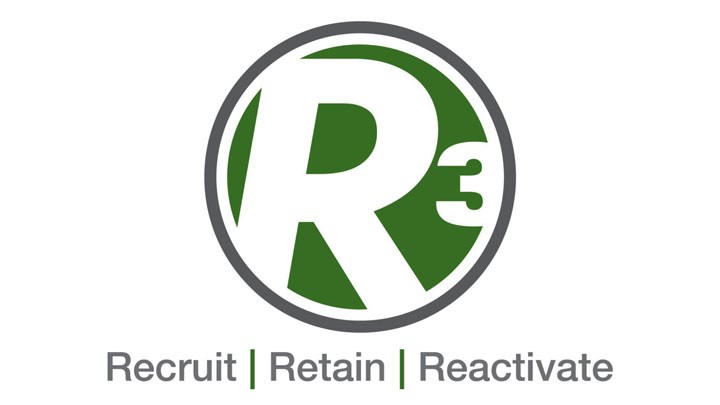
by Chris Chaffin - Monday, May 3, 2021

There is some good news on the hunter recruitment, retention and reactivation front known as the national “R3” movement. In responding to the needs of new hunters and in protecting the future of hunting and the shooting sports, the R3 community continues to deliver tools to help spur and sustain this continued growth. One such tool is the free 2021 Virtual R3 Forum being conducted by the Council to Advance Hunting and the Shooting Sports on Wed., May 5, from 12-5 p.m. EST appropriately themed “Keeping the COVID Cohort.” If you missed the news on the event and are a hunting and shooting sports professional who has not yet registered, please click here or email Swanny Evans, CAHSS Manager of Partnerships, at [email protected].
For more good news, CAHSS conducted a study in conjunction with Southwick Associates earlier this year to investigate how hunters’ rates of purchasing licenses changed during the COVID-19 pandemic. It collected monthly resident and nonresident hunting license data from more than 40 state wildlife agencies to compare 2020 trends to 2019 hunting license sales levels. CAHSS reports that in the 40 states it surveyed between 2019 and 2020, data shows an average increase of 5.4 percent in resident hunting license sales and a 1.6 percent increase in non-resident sales. Thirty-five of the 40 states that responded experienced an overall increase in the number of license sales in 2020. Of course, much of the growth in hunter numbers over the past year has been driven by COVID-19 lockdowns and concerns over food chain disruption in addition to the fact that hunting inherently is a way to social-distance and escape to the outdoors.
But people did escape to the outdoors … in growing numbers … in many states. New license buyers in Michigan increased 67 percent compared to new license buyers in 2019. They also saw a 15 percent increase in female hunters and “moderate growth” in many of the younger age groups. In addition, the state also increased the sales of apprentice licenses by 46 percent.
According to Dustin Isenhoff, marketing specialist with the Michigan Department of Natural Resources, “We have over 100,000 new hunting customers this year. That's a big opportunity for us to work with those folks to keep them involved.”
In other states, early license sales data for 2020 showed more encouragement.
Nevada saw hunting licenses jump 30 percent and put 50 percent more people through its hunter safety class. Maine reported it sold a record number of deer permits and an overall rise of 9 percent in hunting—“with young adult hunters and women making up its fastest-growing groups.”
Washington State also graduated more than twice as many residents from its hunter safety program than it did in 2019 and reported license sales were up 8 percent compared to the same period in 2019. Also in the West, Idaho sold 28 percent more hunting and fishing licenses to first-time buyers.
Other states reporting hunting license sales increases in 2020 compared to 2019 include: California (9 percent), Ohio (6 percent), Wyoming (5.6 percent), Oklahoma (15 percent resident hunting licenses), South Dakota (8.8 percent resident licenses) and New Jersey (5 percent).
While state agencies are quick to say that data from just one year is not a reliable statistic when identifying a trend, the license sales numbers did show a significant jump in 2020 compared to longer term trends—maybe even historic. However, for hunters everywhere, it’s important to note that we should feel good about the progress in 2020 but not look past the long-term trend that still shows hunter numbers far below the levels seen in previous decades.
It is interesting to note that COVID-19 may have positively impacted these increases, with people looking for new and safe ways to socially distance themselves and still enjoy the outdoors. Also of interest is the data from some states indicating the pandemic may have provided the opportunity for those who were already interested in hunting to go hunting for the first time. There were state reports of increases in small game hunting and the trend of increased participation of women hunters also was evident. For a final bit of good news, it appears some state wildlife agencies streamlined their hunting application and license sales processes to both encourage and accommodate new hunters.
While there’s more R3 work ahead of us to recruit, retain and reactivate new hunters and generate the hunter-backed funding for wildlife conservation into the future, 2020 should be a beacon of encouragement for us all. To push forward on your own efforts as soon as this week, I hope you will join me in attending the 2021 Virtual R3 Forum, which again is free of charge and is a short half-day commitment. Together we can go far in “Keeping the COVID Cohort.”
About the Author
An outdoor communicator for more than 40 years, Chris Chaffin has worked with multiple outdoor companies, including serving two terms as treasurer of the Professional Outdoor Media Association before taking on the roles of vice president, president and chairman of the board. In 2007, he launched the communications consulting company Chaffin Communications, Inc. With support from the Outdoor Adventure Dream Giveaway, in 2012 he founded the Outdoor Adventure Conservation Fund, a Florida non-profit encouraging more people to get involved in traditional outdoor activities.
E-mail your comments/questions about this site to:
[email protected]
